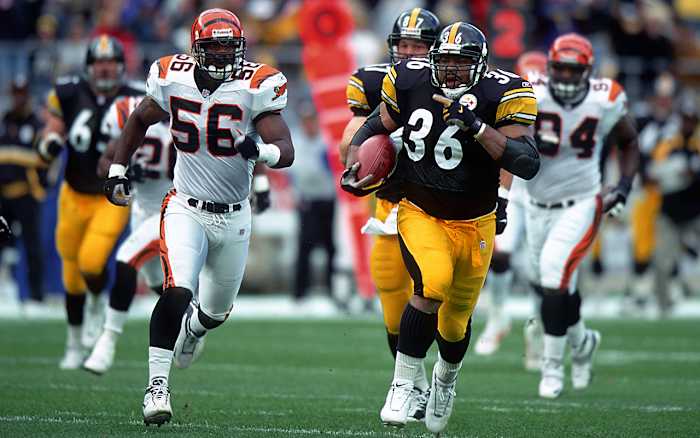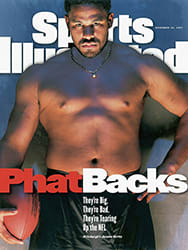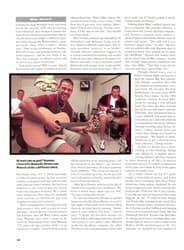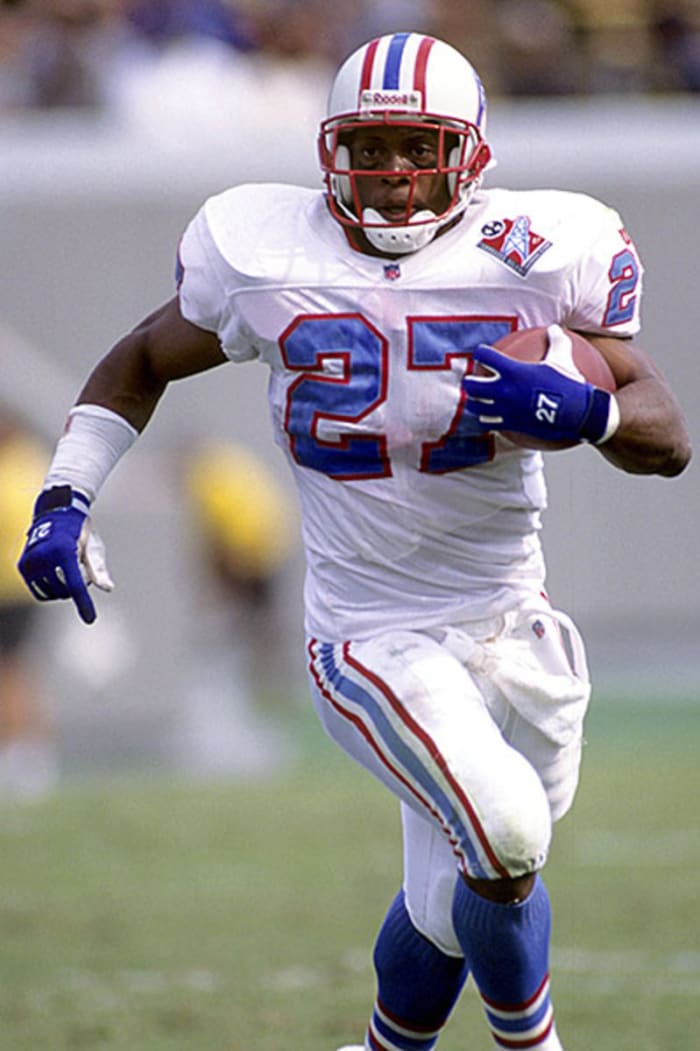Big Bang Theory
Today's big back must be merciless and, when the need arises, light on his feet. When Steelers linebacker Greg Lloyd stumbled into his line of fire at Pittsburgh's Paintball Sports Arena last Friday afternoon, Jerome Bettis stitched a Jackson Pollock up his teammate's right side, pirouetted gracefully and then took out Jason Gildon, another linebacker, with four rounds to the torso. Bettis was doing what a big back needs to do. He was wearing down the defense.
Two days later Bettis was splattering Cincinnati Bengals, powering for 101 yards on 25 carries in a 20-3 win at Three Rivers Stadium. Every so often, just to remind the Bengals that he's more than a Sherman tank, he would throw in a hip fake or stutter step, but these feints were like a brooch on a hippo. For the most part, the man with the blue-collar nickname, the Bus, flat ran over people.
As the weather turns foul north of the Sunbelt and the playoffs draw nigh, we take this opportunity to celebrate the NFL's bulkier backs, the moundlike men who move the pile on third-and-one, who are at home running between the tackles, who, for the most part, lack abdominal definition. "It used to be I was considered a big linebacker," says the Arizona Cardinals' Eric Hill, a ninth-year player who goes 6'2", 253 pounds. "Now there are backs about as big as I am. It's a scary profession."
Big backs have been around since the league's Pleistocene epoch (box, page 38). What is unprecedented about the current crop is the array of skills its members boast. The ability to pound the ball inside is but a single line on their resumes. When there is no daylight, they have the vision to find a seam, the agility to step over bodies and the speed to get outside. What's more, they can make people miss, break long runs and catch the ball out of the backfield. Says Steelers coach Bill Cowher, "They're unique people. They're hard to find." And hard to feed.
Along with the Bus (5'11", 243 pounds), the Tennessee Oilers' Eddie George (6'3", 232), the Jacksonville Jaguars' Natrone Means (5'10", 240) and the Baltimore Ravens' Bam Morris (6 feet, 245)--come to think of it, the AFC Central is also Big Back Central--this fraternity of dancing bears includes ballcarriers with whom you may be less familiar. Buffalo Bills rookie first-round pick Antowain Smith (6'2", 224 pounds, 4.48 in the 40) was identified last week by Denver Broncos coach Mike Shanahan as the "toughest, strongest" back his team would face this season. Jamal Anderson, a 5'11", 234-pound wrecking ball of a runner, is the Falcon who made 250-pound Craig (Ironhead) Heyward expendable in Atlanta.
"They're broadening their horizons," says Tampa Bay Buccaneers coach Tony Dungy of today's abnormally large, swift runners, one of whom, 248-pound Mike Alstott (following story), plays for him. "They're like basketball guards. Guys who are six-six, six-seven are doing things little men used to do." Consider Atlanta's Anderson, who has been known to line up as a wide receiver and run a "go" route on one play and then run an off-tackle blast on the next.
At a post-Paintball repast, as he worked his way through a basket of tortilla chips at a Mexican restaurant near his apartment, the Bus related some of the sights and sounds experienced by a big back on game day: "First series, they're coming at you like gangbusters. They're swarming to the ball, talking a lot of mess. 'Bus grounded today, baby.' Stuff like that. By the last series guys aren't coming to the ball nearly as fast. I'm coming at them, and they're looking around, like, O.K., who's with me?"
As the Steelers have built their 8-3 record this season, Bettis has taken untold pressure off quarterback Kordell Stewart, who is in his first season as a starter. Bettis's 1,238 rushing yards place him second in the NFL, 162 behind the Broncos' Terrell Davis. It is his appetite for collisions, as much as the fact that he has surpassed 100 yards rushing in 18 of his 27 games as a Steeler, that has caused Pittsburgh fans to embrace him. (We mean this figuratively. One reason the ample-bellied, massively derriered, thunderously thighed Bettis is so hard to bring down, says Steelers running backs coach Dick Hoak, is that "it's hard to get your arms around him.")
Investors take note: We are approaching that time of year when the stock of the big back rises. The nastier the weather, the tougher it becomes to throw. Games with playoff implications are followed by playoff games; coaches become more conservative. If you have a big back, says Cardinals defensive coordinator Dave McGinnis, "you have something safe, someone who is moving the chains, shortening the game."
Asked last week if big backs are more valuable late in the year, Shanahan replied, "We'll find out shortly." He already knows. One of last season's most shocking sights was that of Means gashing Shanahan's defense--the NFL's best against the run in 1996--for 140 rushing yards in the Jaguars' 30-27 second-round playoff upset of the Broncos. A week earlier Means had run for 175 yards in Jacksonville's wild-card playoff win in Buffalo.
Means still doesn't see why everyone was so surprised by his big games. "Those were cold, loud places, where you're going to have trouble calling audibles, where you can't line up and throw it on every down," he says. "The best thing to do is to snap the ball on the quick count and pound it up in there."
Like Bettis, Means is blessed with sweet feet. Like Bettis, he wears down defenders. How does he know? They tell him. "What I like is in the second half, when guys start making arm tackles," says Means. "They start groaning when they get up and saying things like, 'I'm tired of tackling your big ass.'"
Means weighed in at 272 pounds when, shortly after having been waived by the San Diego Chargers, he signed with the Jaguars in March 1996. Today he's a trim (for him) 240 pounds and proudly points out that he put on just three pounds in the off-season. "I get tackled," says Means, "but never by just one guy. To a big back like me, that's like a slap in the face."
Some big backs screw up on a correspondingly grand scale. There have been the cannabis- and alcohol-related misadventures of Morris, who as a Steeler in March 1996 was pulled over by police in Texas and found to have six pounds of marijuana in the trunk of his car. The Steelers waived Morris, who received probation after pleading guilty to a felony marijuana-possession charge. He was signed by the Ravens, then served a five-game suspension for violating the league's substance-abuse policy. Despite missing four games for another substance-abuse violation this year--he tested positive for alcohol--Morris has run for 517 yards on 126 carries in 1997. He sat out Sunday's game against the Philadelphia Eagles with ankle and toe injuries, but those are the least of Morris's problems. As a result of the positive test, he faces a hearing in Texas for violating his parole, and on Monday he was charged with second-degree assault for allegedly choking a woman at the birthday party of a teammate on Sunday night.
The latest big back to dig himself out of a big hole is the Chargers' Gary Brown, who as a 229-pounder in 1993 with the Houston Oilers rushed for 1,002 yards, averaging 5.1 yards per carry. After the '95 season the Oilers cut Brown, who had gained weight and seemed to have lost interest in football.
Brown spent the 1996 season moping around his native Williamsport, Pa., exploring how many hoagies and cheese steaks he could put away in a day. (Brown reports that he usually topped out at eight.) "I was feeling sorry for myself," he says. "I kind of got overweight." Kind of? At one point Brown's weight ballooned to 262. He had lost his job and his lap. One day he became so disgusted with his condition that he vowed to lose the weight and return to the NFL. He got down to 220, and the Chargers signed him to a one-year, $300,000 contract that included a $1 million bonus if he rushed for 1,000 yards. It looks as if Brown's going to collect. Through 11 games he has 816 yards.
"The money's not an issue for me," he says, and it's possible that he means it. "The Oilers paid me five million bucks [over three years]. To me it's more important that I'll never have to look in the mirror and admit to myself, You gave up."
After regaining his self-respect, Brown earned the respect of the Oakland Raiders, whom he ran around and through for 181 yards on Oct. 5. He followed that three weeks later with a 169-yard day against the Indianapolis Colts.
While the aforementioned big backs possess physiques of the type seen in The Full Monty, George is more of a Chippendale: 6'3", 232 pounds. "He's not so much a big back as a freak," says Brown. George gained a franchise-record-tying 216 yards in the Oilers' season-opening win over the Raiders and has rushed for 1,031 yards this year.
How best to contain today's big backs? What advice does a coach give players assigned to stop these runaway vehicles? "Eat more," says Bills defensive coordinator Wade Phillips.
"Grab cloth and wait for help," says Seattle Seahawks defensive coordinator Greg McMakin.
"Get him running laterally," says Cowher. "Play gap control and force him to bounce things outside."
"Hit him with numbers," adds McGinnis. "Everyone says, 'Go low,' but eventually you go so low you're missing tackles. You've got to swarm to the football."
Other suggestions:
"Don't worry about how it's going to look on SportsCenter," says Eugene Robinson, the Green Bay Packers' 195-pound free safety. "If I'm downfield covering a receiver, and now I'm going to take on a 250-pound back with a head of steam, physics tells me I'm going to lose the battle. That's O.K. The important thing is to get him on the ground, even if you get run over doing it."
No one who has seen Bettis lay out a hapless defensive back can be surprised to learn that before starring at Notre Dame as a fullback, he was all-state as a linebacker and a running back at Detroit's MacKenzie High. "I loved it," the Bus says of his defensive role. "I just wanted to crack somebody."
Back then Bettis would get home from practice and head to the bowling alley with his mother, Gladys. She made him go to keep him off the streets. He relates this between sips of a virgin strawberry daiquiri. It's the roly-poly, daiquiri-drinking mama's boy, more than any other Steeler, who gives Pittsburgh its brutish identity.
"When you get one of these guys going," says Bills offensive coordinator Dan Henning, who has coached John Riggins, Marion Butts, Gerald Riggs and William Andrews--this guy was into big backs before big backs were cool--"he becomes a flag bearer for your team. He sets the tone."
Robinson remembers trying to tackle Bettis at the 1994 Pro Bowl, an otherwise pleasant experience for the safety. "After you tackle him, you're laughing and joking with him," says Robinson. "But on your way to the huddle you're thinking, Oh boy, I'm in trouble."



